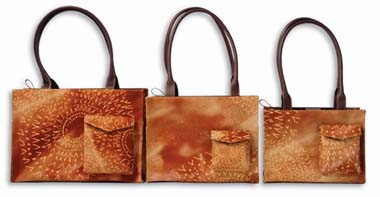|
 GOOD
[HAND]BAG
becomes an intimate extension of the body. A second sex … a belly
for concealment [and] a little house for a mobile life.’ So said
magazine writer and author Anna Johnson in the introduction of her
engrossing, highly educational and entertaining book, Handbags:
the Power of the Purse. Ms Johnson, a very good writer indeed,
through the photography by Eri Morita and text that flows like a
carefully constructed river, takes her reader through the history
of the handbag, explains in a light but informative manner how it
has evolved over the centuries and how it continues to do so as
a result of talented artisans who amazingly come up with new and
ingenious ways to expand the vocabulary and collections of women
worldwide. GOOD
[HAND]BAG
becomes an intimate extension of the body. A second sex … a belly
for concealment [and] a little house for a mobile life.’ So said
magazine writer and author Anna Johnson in the introduction of her
engrossing, highly educational and entertaining book, Handbags:
the Power of the Purse. Ms Johnson, a very good writer indeed,
through the photography by Eri Morita and text that flows like a
carefully constructed river, takes her reader through the history
of the handbag, explains in a light but informative manner how it
has evolved over the centuries and how it continues to do so as
a result of talented artisans who amazingly come up with new and
ingenious ways to expand the vocabulary and collections of women
worldwide.
Psychiatrists see the ladies’ handbag as the ‘only
place a man’s hands are unwelcome.’ Surrealists sliced them up and
used them in collages and sculptures. And celebrities throughout
the ages, by virtue of their perceived power, gives an even more
powerful mystique to the handbags they chooses to carry, as seen
by Grace Kelly using her Hermès to shield her out-of-wedlock
pregnancy before going off to self-imposed exile in Europe.
The first handbag, explains Ms Johnson, was probably
a piece of animal skin held together with string and used by cavemen
and women. But that incidental accessory that we all cannot do without
evolved into the unisex drawstring purse used by both men and women
as early as the Christian Crusades and the Coliseums of Ancient
Rome. But, as with most things in history, the handbag achieved
its greatest leap of evolution in the Middle Ages when women of
means began carrying tiny, embellished “coin” bags as
a way of inferring their upper-class status and breeding. Big, bulky
shoulder bags worn across the body then implied a hard day’s work
and that one was of peasant stock. Even then, it takes very little
to heat up class wars between the masses and the rich.
| Psychiatrists see the
ladies’ handbag as the ‘only place a man’s hands are unwelcome’ |
But it did more than that. When the first real
leather handbag was created in the 1860s, it was the need for a
sturdy travelling bag that drove the trend. That bag was the first
to come equipped with a lock, key and a ticket compartment. An unexpected
effect was that it gave women some independence from their husbands
who were no longer needed to carry their wives’ fans or money.
As time progressed, many people contributed to the
elevation of the handbag as an accessory with a place of importance
in history that no one can deny. These artisan–designers, through
fate or otherwise, created handbags that have achieved iconic importance
and innumerable riches for their companies. Emile-Maurice Hermès
created the now famous Kelly Bag, as well as the Birkin (made even
more memorable by Kim Cattrall in a fourth season episode of HBO’s
Sex and The City, in which she connived to no end to jump the
line at New York City’s flagship Hermès store to get her hands
on a $5,000 black Birkin). Louis Vuitton, in an effort to thwart the
counterfeiters, painted his logo on his bags; and started a trend
that is still alive and kicking today. Witness the new line from Marc
Jacob’s Louis Vuitton spring 2003 collection (multi-coloured LV
logo on solid colour leather background and Coach’s best-selling line
(a small c marching across the surface in military lockstep).
Coco Chanel, a modern master of fashion design, took the weighted
gilt chains out of the hemlines of her suits and fashioned them into
shoulder straps for her entry into the handbag derby. It worked like
a charm.
It was in the ’80s and early ’90s that the handbag
craze caught fire in a very big way. Miuccia Prada, having taken
over her grandfather’s leather factory, leaped to prominence with
her first of many iconic cult favorites, a black, ripstop nylon
backpack. This opened the floodgates to a new renaissance in handbag
design. Ms Prada followed up her opening salvo with other designs
in primarily masculine shapes (the lunchbox, the medical bag) in
leather, silk, satin and velvet. She ultimately used her dominance
in the handbag field to later conquer the rest of the design world.
But the other players in the industry were not
willing to leave all that money on the table without making a run
for some of it themselves. Christian Dior came out with the Lady
Dior, a confection of overstitching and a cluster of logo letters
dangling from the handle. Tom Ford took over as creative Director
of Gucci, Inc. in 1992 and one of his first tasks as head of the
design team, after first cleaning up the mess left behind by members
of the Gucci family, was to reintroduce the Gucci bag to a panting
audience. His rendition of the Gucci bag was successful because
he took only the best qualities—the bamboo handle, the glossy insignia
and the well-known bold striped canvas—and turned around the perception
that all things Gucci was schlock and not well-made.
CONTINUED


|